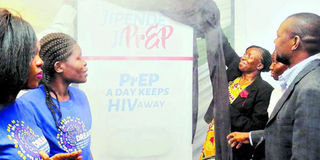One in seven individuals offered PrEP start it immediately

Kisumu Health Fraternity launch Pre-Exposure Prophylaxis Pills (commonly known as Prep) in Kisumu County on July 11, 2017. Dr Elizabeth Ogaja said this everyday pill is expected to reduce new HIV infections by at least 30% in Kisumu County annually. PHOTO| TONNY OMONDI
One in seven people who tested HIV-negative and were offered pre-exposure prophylaxis (PrEP) for being at high risk of contracting the virus started taking it the day it was offered.
Among people who were outside the risk score who were also given a chance to request PrEP, nearly 40 per cent started it within 30 days, meaning that more people who self-referred ended up taking PrEP than those who were told they were at risk after testing.
Another 18 per cent started the treatment within a month after it was offered, according to a presentation at the recent International AIDS Society Conference on HIV Science in Paris.
THE NUMBERS
Of those who were considered to be at high risk of HIV, only 11 per cent started PrEP within 30 days.
In November 2015, participants of a large community study in Kenya and Uganda, who tested HIV-negative, but were considered to be at high risk of HIV, started being offered pre-exposure prophylaxis (PrEP). They were part of large community study that focused on HIV testing and treatement.
Risk was measured based on age, gender, marital status, education, occupation, circumcision in men, alcohol use and polygamy.
Of 21,000 people who tested HIV-negative, 14 per cent were categorised as being at high risk of contracting the virus and were offered PrEP during post-test counselling.
A further five per cent heard about PrEP during health campaigns and opted to discuss it with health professionals. Altogether, one in five people were categorised as potential PrEP users.
Of these, 14 per cent started taking PrEP the day it was offered, while 18 per cent started within 30 days.
Those who self-referred were more likely to start taking PrEP within a month than those who were offered PrEP after testing for HIV, because they were considered as high-risk.
Interestingly, only 30 per cent of participants assessed by the researchers as being at high risk of HIV infection actually considered themselves at high risk, whereas half of those who self-referred did.
Men were more likely to start on PrEP within 30 days than women. Early adopters of PrEP were also likely to have no higher than primary education, more likely to perceive themselves as being at high risk of HIV, more likely to be polygamous and more likely to have a HIV-positive spouse.
They were also five times more likely to have been assessed at a community health fair, rather than during household testing. Among those who were not considered at risk but nonetheless started PrEP, early adopters were older (those aged 46 to 55 were more likely to start than under-25s), more likely to have no more than primary education, more likely to have a HIV-positive spouse and more likely to have been tested at home rather than at a community health fair.
However, there was no correlation between self-perception of current HIV risk and deciding to start PrEP. The people who decided not to start PrEP said that they would have preferred to take it on demand, rather than daily.
Women also said they preferred periodic injections, like with injectable contraceptives which are given once a month or once every three months, while young people assumed that they would need parental consent to start.


